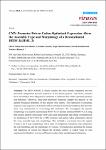CMV-Promoter Driven Codon-Optimized Expression Alters the Assembly Type and Morphology of a Reconstituted HERV-K(HML-2)
Hohn, Oliver
Hanke, Kirsten
Lausch, Veronika
Zimmermann, Anja
Mostafa, Saeed
Bannert, Norbert
The HERV-K(HML-2) family contains the most recently integrated and best preserved endogenized proviral sequences in the human genome. All known elements have nevertheless been subjected to mutations or deletions that render expressed particles non-infectious. Moreover, these post-insertional mutations hamper the analysis of the general biological properties of this ancient virus family. The expression of consensus sequences and sequences of elements with reverted post-insertional mutations has therefore been very instrumental in overcoming this limitation. We investigated the particle morphology of a recently reconstituted HERV-K113 element termed oriHERV-K113 using thin-section electron microscopy (EM) and could demonstrate that strong overexpression by substitution of the 5'LTR for a CMV promoter and partial codon optimization altered the virus assembly type and morphology. This included a conversion from the regular C-type to an A-type morphology with a mass of cytoplasmic immature cores tethered to the cell membrane and the membranes of vesicles. Overexpression permitted the release and maturation of virions but reduced the envelope content. A weaker boost of virus expression by Staufen-1 was not sufficient to induce these morphological alterations.
Dateien zu dieser Publikation
Keine Lizenzangabe

